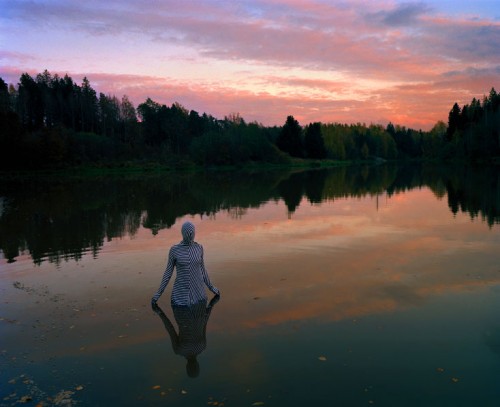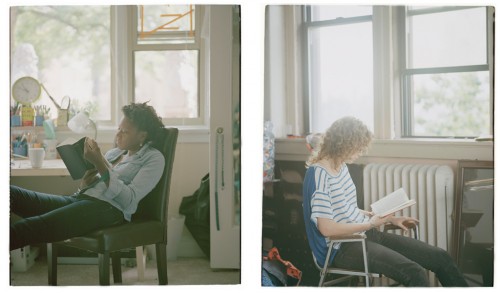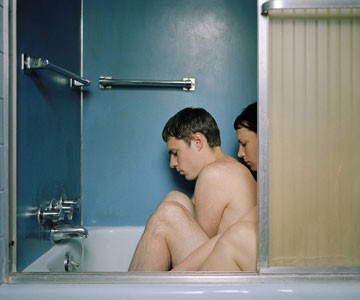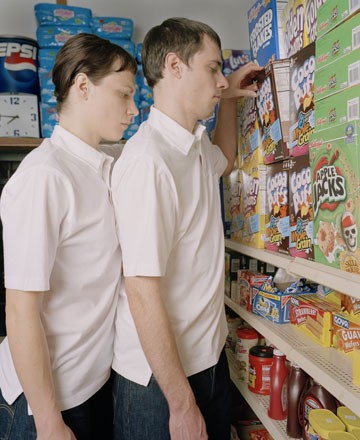
Carrie Schneider. “WE (Baltic Version),” 2008. C-print, 58 x 76 in. Courtesy the artist and Monique Meloche Gallery.
Carrie Schneider arrived in Helsinki, Finland already feeling an an intrinsic, intuitive connection with artists from the region. Her one-year Fulbright fellowship (2007-2008) at the Finnish Academy of Fine Arts only intensified her affinity to the style of Finnish women artists, which might be described as emotionally resonant yet visually sparse.
Schneider’s experience in Finland not only provided opportunities for dialogue with local artists, but also offered a release from the intense pressures presented by graduate school; she received her MFA from the School of the Art Institute in 2007.
“I was obsessed with the work of Finnish artist Salla Tykkä,” says Schneider. “When I was in graduate school, I was part of a visiting artist community that invited her to speak at the Art Institute of Chicago, and do public lectures and studio visits. I got to know her really well, and when I was in Helsinki, I got to work with her as one of my advisors on the Fulbright project.”
Schneider also had an opportunity to learn from Finnish filmmaker Eija Liisa-Ahtila, another artist she greatly admired.
Schneider is a master at capturing heightened emotional moments. This ability appears in one of her most recent bodies of work entitled Reading Women (2012) in which she documents her female friends—mostly writers, artists, and musicians—completely engrossed in a text. Schneider invites friends to read in her home for about two hours; she watches them in a curious, yet non-voyeuristic way, and snaps the photograph in the moment of complete immersion—when the subject is lost in the book.

Carrie Schneider. “Cauleen reading Gwendolyn Brooks,” and “Molly reading Roseanne Barr” from the series “Reading Women” (in progress). All photos 2012. C-prints. Courtesy of the artist and Monique Meloche Gallery.
“What initially compelled me to begin the project is mirrored in the portraits themselves: a young artist’s desire to connect with another creative voice in a way that resonates with her own art and life,” Schneider told Jessie Wender of the New Yorker.
Schneider’s fascination with building an art practice about intense psychological experiences, which are essentially agreements between two subjects or the subject and the artist, are very much rooted in the Finnish artists with whom she worked during her Fulbright fellowship.
“There’s this tendency toward extreme formality [in the work of Finnish artists I worked with], which could seem very cold or distancing. But there’s also something really psychologically hot in there, borderline psychedelic, because there’s this extremeness that they call ‘sisu,’ like this internal strength,” she explains. “There’s this formality that can seem sort of stilted. There’s something about it that’s unnatural and then there’s something intense and crazy. That’s what I was attracted to in Eija Lisa-Ahtila, Liisa Roberts, and Sala Tykkä.”
Schneider’s connection to Finland is not entirely owed to her Fulbright project. Her paternal grandmother was born in Finland and emigrated to Wisconsin as a child. Schneider had never visited but says that she “felt really strongly connected to a lot of Finnish women video artists.”
For sure, the aesthetic connections between Schneider’s work and that of the artists she mentions is astounding, and very much against an American impulse to oversaturate. Ways of talking about intense psychological and personal relationships without any of the gushy colors or emotive language so common in America is a challenge that Schneider happily confronts. In the series Derelict Self (2006–2007), she examines her close relationship with her brother through the idea of mimicry. Although emotionally intense, the photographs are never sexual in nature, but closer to the emotional closeness and symbiosis apparent in twin relationships.

Carrie Schneider. “Derelict Self: Bathtub,” 2006–2007. C-print, 30 x 36 in. Courtesy the artist and Monique Meloche Gallery.

Carrie Schneider. “Derelict Self: Grocery Store,” 2006–2007. C-print, 30 x 36 in. Courtesy the artist and Monique Meloche Gallery.
During her residency in Finland, Schneider started working on a larger project to construct a new identity through the creation of her own mythology. Utilizing the language of macho-masculine artists such as Joseph Beuys, Matthew Barney, and Ingmar Bergman, she positioned herself as a power figure within the art historical canon. Schneider sought to construct an identity that was “less specific” to her own experience and more about “the mythological identity of an artist…and what the potential of that could be.”
Her work in Finland became about imagining herself as part of the natural landscape, which allowed for a sort of playfulness that the confines of a gendered art historical context do not allow. She returned from Finland with a series of photographs, We and Dazzle, and two films, Utö (2008) and Dress of Good Weather (2008), in which she morphs into and transforms both her body and the Finnish landscape, merging and melting them into a singular being.
Despite the fact that much of her previous work had been performative, it wasn’t until Finland that Schneider started to make films.
“To get a chance to make short narrative films really changed everything,” says Schneider. “Ever since then the large bodies of work that I have made have existed in still and moving images; they are about time, performing something specifically for the camera, and whether it is a still camera or a moving image.”
Currently in Buenos Aires, Schneider is collaborating with a few artist friends that she met in Florida at the Atlantic Center for the Arts Residency (with Master Artist Rineke Dijkstra) and in Maine at the Skowhegan School of Painting and Sculpture. “Sometimes getting away helps me to be productive,” says Schneider. “But more often it’s having an opportunity to break from my routine, to spend time reconnecting with friends, experiencing new foods and places, and even just getting to loaf! There’s something valuable about this that extends beyond the studio.”

Carrie Schneider. “Burning House (February, sunrise)” from the series “Burning House,” 2010 – 2011. C-prints, 40 x 50 in. Courtesy the artist and Monique Meloche Gallery.
In Argentina, Schneider is exhibiting Burning House (2010-2011) with artist Cecilia Lopez as a performance video projection with live music. (Another version of the work was shown last year at Monique Meloche Gallery in Chicago.) In this photography series, Schneider’s returns twelve times to a small island in rural Wisconsin. On every visit, she canoed out to the island, set a house ablaze, paddled away, and documented the flames. At first glance, the scene appears to take place in Finland. Or perhaps, at this point, Schneider has figured out how to merge the two locations in a single lens.
Carrie Schneider is based in Brooklyn, New York. In addition to her show at Monique Meloche, she has had solo exhibitions at the Museum of Contemporary Art, Chicago; Finnish Museum of Photography, Helsinki; and Galleri KiT, Trondheim. She has completed nine residencies to date.
Alicia Eler Blogger-in-Residence through February 28. To read Alicia’s previous coverage of Carrie Schneider, visit her website and check out her 2007 piece for Centerstage Chicago.



